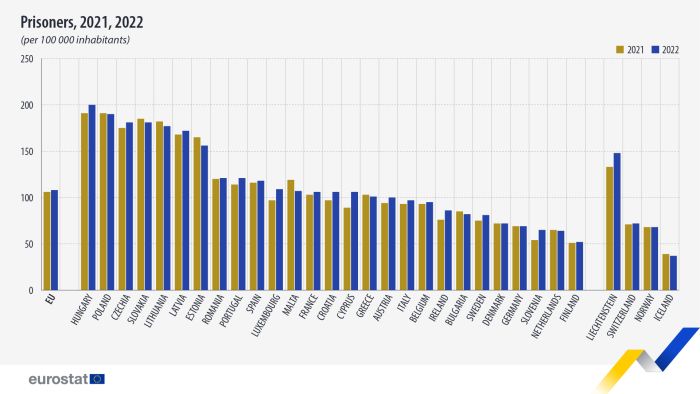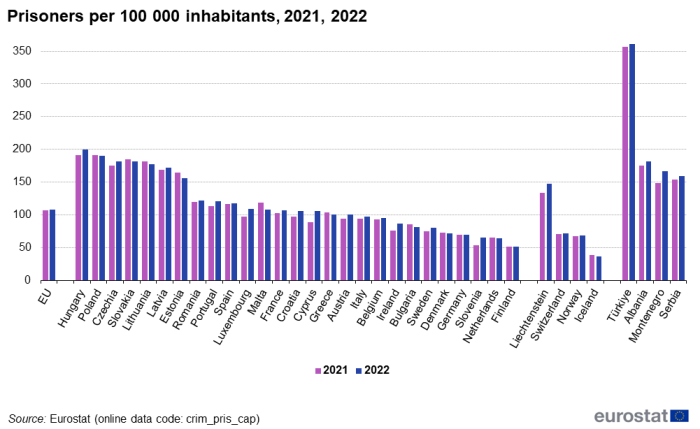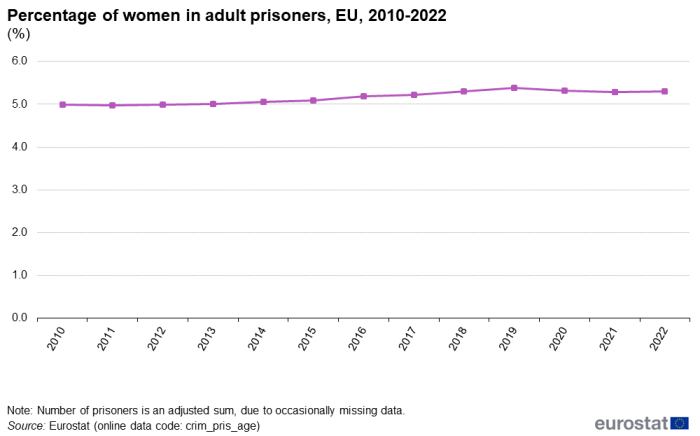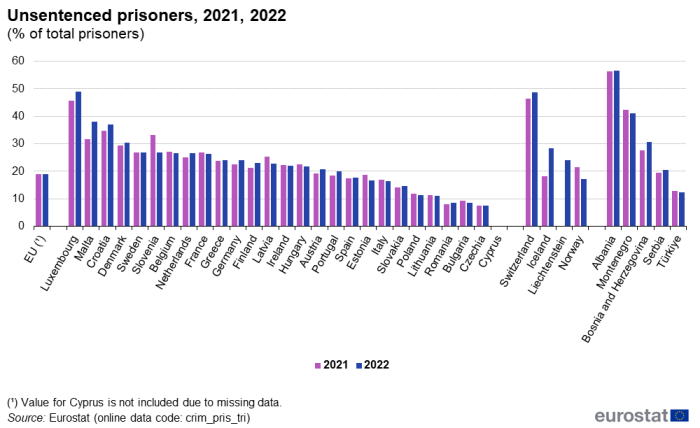Prison statistics
Data extracted in April 2024.
Planned article update: April 2025.
Highlights
This article presents European statistics on prisoners. Prisons occupancy data are included in the prison occupancy statistics article. Prison personnel data are presented in police, court and prison personnel statistics. Countries' compliance with the classification of crimes and counting methodologies is explained in the crime metadata.
Full article
One prisoner per 924 inhabitants in the EU in 2022
There was one prisoner per 924 inhabitants in the EU in 2022, or 108 prisoners per 100 000. The prisoner rate increased in 2021 and in 2022, after the decline in 2020 that was probably due to COVID-19 measures. The 2022 rate is, however, the third lowest figure since the turn of the century just after the values of 2020 and 2021. The highest prisoner rates per 100 000 in the EU in 2022 were in Hungary (200), Poland (190), Czechia and Slovakia (181 both). The lowest rate was in Finland (52), followed by the Netherlands (64), and Slovenia (65). In 16 of the EU countries, the prisoner rate increased compared with 2021. Figure 1 presents data for all countries that provided prison statistics to Eurostat.
An increase in the number of prisoners in 2022 after the drop in 2020 and 2021
There were around 483 600 prisoners in the EU in 2022, which is still 12.5 % less than in 2012, when there were around 553 000 prisoners, the highest number since 1993. The number of prisoners in the EU rose by 24.0 % from 1993 to 2012, due to a previous rise in serious crimes across Europe[1]. In the same period, the population of the EU grew by just 4.4 %. This resulted in the prisoner rate per 100 000 inhabitants increasing from 106 in 1993 to 126 in 2012. From 2012 to 2016, there was a downward trend in the number of prisoners, resulting in an overall reduction by 12.4 %. After a period of stability in 2017-2019, there was a significant decrease of 6.6 % in the number of prisoners in 2020, probably due to COVID-19 related measures, followed by a slight increase of 2.5 % in 2021 and of 1.7 % in 2022.
A net increase in the number of prisoners is due to a number of new prison sentences higher than the number of releases. After an increase in serious crimes followed by more convictions with longer sentences, the number of prisoners may remain on a higher level for a while, even if the crime rate drops. In addition, large declines in the number of prisoners can be caused by decriminalisation, amnesties and pardons.
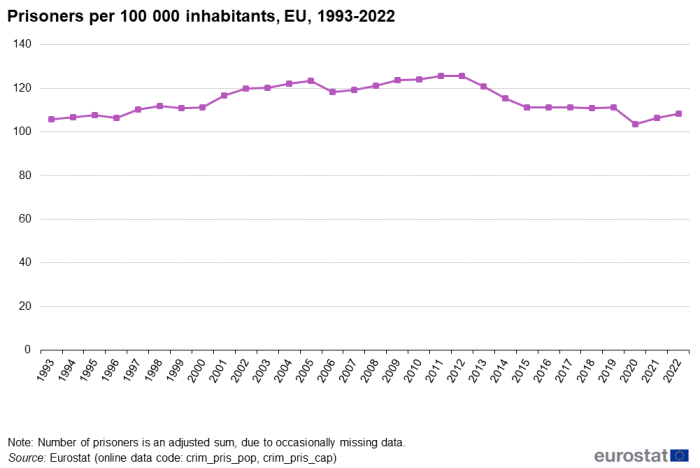
Source: Eurostat (crim_pris_pop) (crim_pris_cap)
In 2022, one out of 19 adult prisoners were women
Since 2016 one out of 19 adult prisoners was female. As shown in Figure 3, the share of women in prisons increased from 2011 to 2019 and decreased slightly in 2020-2022 years. In the EU, the percentage of female adult prisoners was 5.0 % from 2010 to 2013, then increased to reach 5.4 % in 2019 and fell back to 5.3 % in the 2020-2022 period. Compared with 2021, the number of prisoners slightly increased in 2022, by 1.7 % for men and 2.0 % for women.
The share of women in prisons varies between EU Member States (see Figure 4). In 2022, the highest shares were observed in Malta (9.5 %), Czechia (8.5 %), and Latvia (7.7 %). The lowest shares were in France (3.2 %), Bulgaria (3.7 %), and Italy (4.2 %). In 2022, the share of women among adult prisoners increased in 16 out of 26 countries that provided data for both years[2].
One in five prisoners had a foreign citizenship in the reporting country
In 2022, one in five prisoners in the EU had a foreign citizenship in the reporting country. In EU countries, the percentage of detainees with a foreign citizenship in the reporting country (20.4 %) was slightly higher than in 2021 (19.9 %). The share of prisoners with a foreign citizenship varies between EU Member States (see Figure 5). The highest shares were observed in Luxembourg (77.9 %), Greece (57.2 %) and Cyprus (55.4 %). The lowest shares were in Romania (1.1 %), Bulgaria and Latvia (2.4 % both). The percentage increased in 16 out of 26 countries that provided data for both years, while it decreased in 10 EU Member States[3].
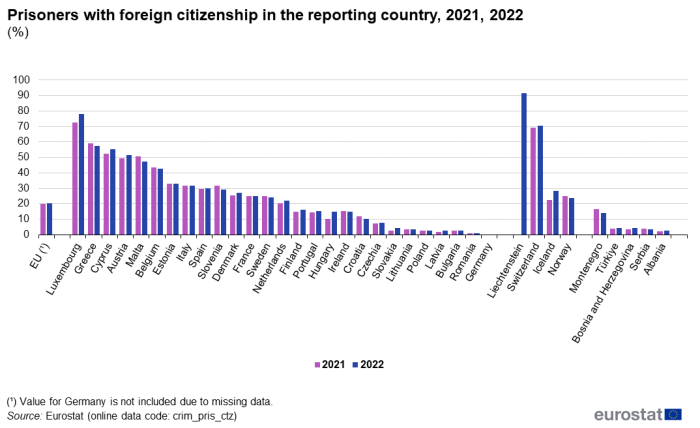
Source: Eurostat (crim_pris_ctz)
One in five prisoners were awaiting trial in 2022
In 2022, 19.0 % of prisoners were awaiting their final trial, this figure slightly increased compared with the previous year (18.9 %). In 2022, the proportion of prisoners awaiting trial was the highest in Luxembourg (48.9 %), followed by Malta (37.9 %) and Croatia (36.9 %). The proportion of prisoners without conviction was much lower in Czechia (7.5 %), Bulgaria (8.5 %), and Romania (8.6 %). Figure 6 shows the 2021 and 2022 values. In 15 out of 26 countries that provided data for both periods, the share of unsentenced prisoners increased in 2022.
Source data for tables and graphs
Data sources
Data sources for prison statistics are national authorities such as prison administration or the national statistical institute. Eurostat collects prison data together with the yearly UN global crime statistics. All results presented in this article are based on official figures.
Missing data is a major problem for some types of crime statistics at European level. When EU totals are calculated to indicate an overall trend, missing figures for countries are estimated with the last available year (of the same country). The EU value of the unsentenced detainees percentage is calculated on responding countries in the web database. Other EU totals presented in this article are not disseminated in the web database. The national figures are presented in the web database as reported (no adjustments).
Eurostat updates the web database when countries send new figures, but older statistical articles may refer to previously reported figures.
Context
In general, each country is responsible for its own criminal laws, criminal justice policies, as well as specifications for relevant statistics. Typically, official statistics on crime and criminal justice are made for administrative purposes and used by national authorities.
Prison statistics are part of official statistics on crime and criminal justice, relating indirectly to crime occurrence and the performance of the criminal justice system.
The number of prisoners (counted at the end of a year) depends on:
- the number in the previous year,
- how many were convicted and actually imprisoned during the year,
- how many left prison during the year: released, pardoned, died, escaped, etc.
The trend in prisoner number depends on:
- how many crimes are brought to court,
- how many are convicted, and actually sentenced to prison,
- length of sentences received, and the actual duration,
- alternative sanctions, early release, amnesties, pardons, etc.,
- law changes, for which types of crime imprisonment is prescribed, and for how long.
Direct access to
See also
Publications
Dedicated section
Notes
- ↑ Source: "crim_gen" Crimes recorded by the police (sum of acts causing harm or intending to cause harm to the person, injurious acts of a sexual nature and acts against property involving violence or threat against a person).
- ↑ Data are missing for Germany in both years.
- ↑ Data are missing for Germany in both years.
